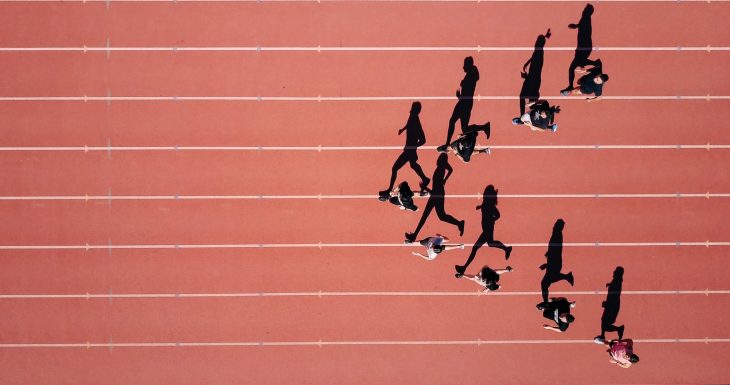
Running is one of the most common activities that creatures with functional feet do every day. Regardless of age, gender and shape, everybody can run if they want or need to. However, not everyone knows too much about the activity except for the moving of the body parts. If that is the case for you, then you have to read these running facts that would make you want to dust off your running shoes today.
- 01Instead of ‘running,’ the activity was known as ‘pedestrianism’ during the late 19th century.
- 02Each step you run consumes movement from 200 muscles.
- 03Doing high knees and heel flicks are more effective than stretching in preparing muscles for a run.
- 04Running can cut the chances of arthritis into half of that of walking.
- 05The last 3 miles of a marathon, known as the most dangerous point, is where most cardiac arrests befall runners.
- 01Running boosts male sex drive as it raises testosterone levels by 15%.
- 02As a high-impact activity, running strengthens and reconstructs muscles as well as bones.
- 03Runners have longer lifetimes than those who do not run.
- 04Running under cold weather is safer than in hot because of high dehydration risks.
- 05Listening to music while running improves performance by 15%.
- 06Scientists found that having baked beetroot ere a race helps athletes run faster.
- 07Your feet produce an average of 1 pint of sweat every day.
- 08Competing runners usually take 185-200 steps per minute.
- 09Some runners have to protect their nipples from chafing and friction by wearing band-aids or rubbing vaseline.
- 1010-mile track runners strike their feet on the ground by 15,000 times using force that is 3-4 times their body’s weight.
- 011 billion pairs of running shoes are sold around the world annually.
- 02Wearing a red outfit increases your chances of winning a race over runners who wear other colors.
- 03If you want to roam the whole planet, you have to run 12 miles every day for 2,075 days.
- 04The ancient Greek Olympiads require participants to run naked.
- 05Cheetah, the fastest animal on earth, could run at 110-120 km/h, while the rest of its feline kind could reach up to 30mph.
Running Facts Infographics
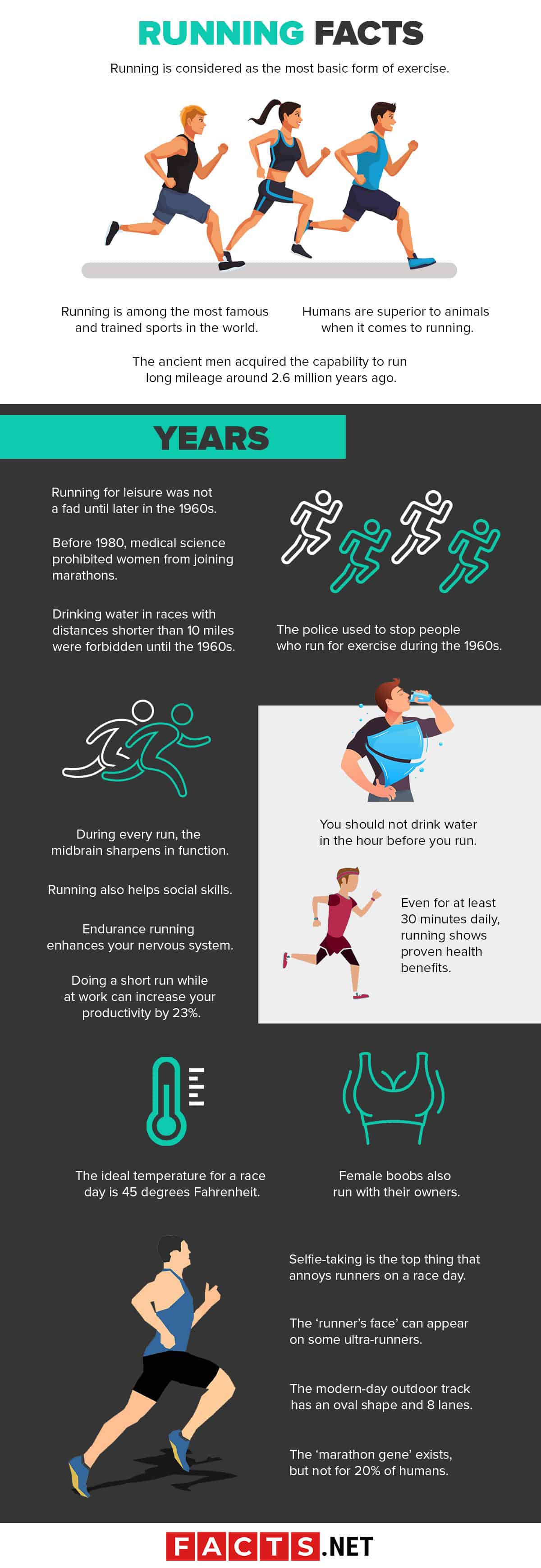
Running is considered as the most basic form of exercise.
While in action, you use your own body, entire weight, and both legs. It also activates 26 bones, 33 joints, 112 ligaments, that work with other blood vessels, nerves and tendons.
Running is among the most famous and trained sports in the world.
In 2017, around 60 million people in the United States engaged in jogging, running, and trail running.
The ancient men acquired the capability to run long mileage around 2.6 million years ago.
Unlike many of today’s usual reasons for running, hunting prey for food was the most probable reason back then.
Humans are superior to animals when it comes to running.
Humans can outrun almost all the animals in the world over long distances. A few exceptions include cats, rabbits, and kangaroos.
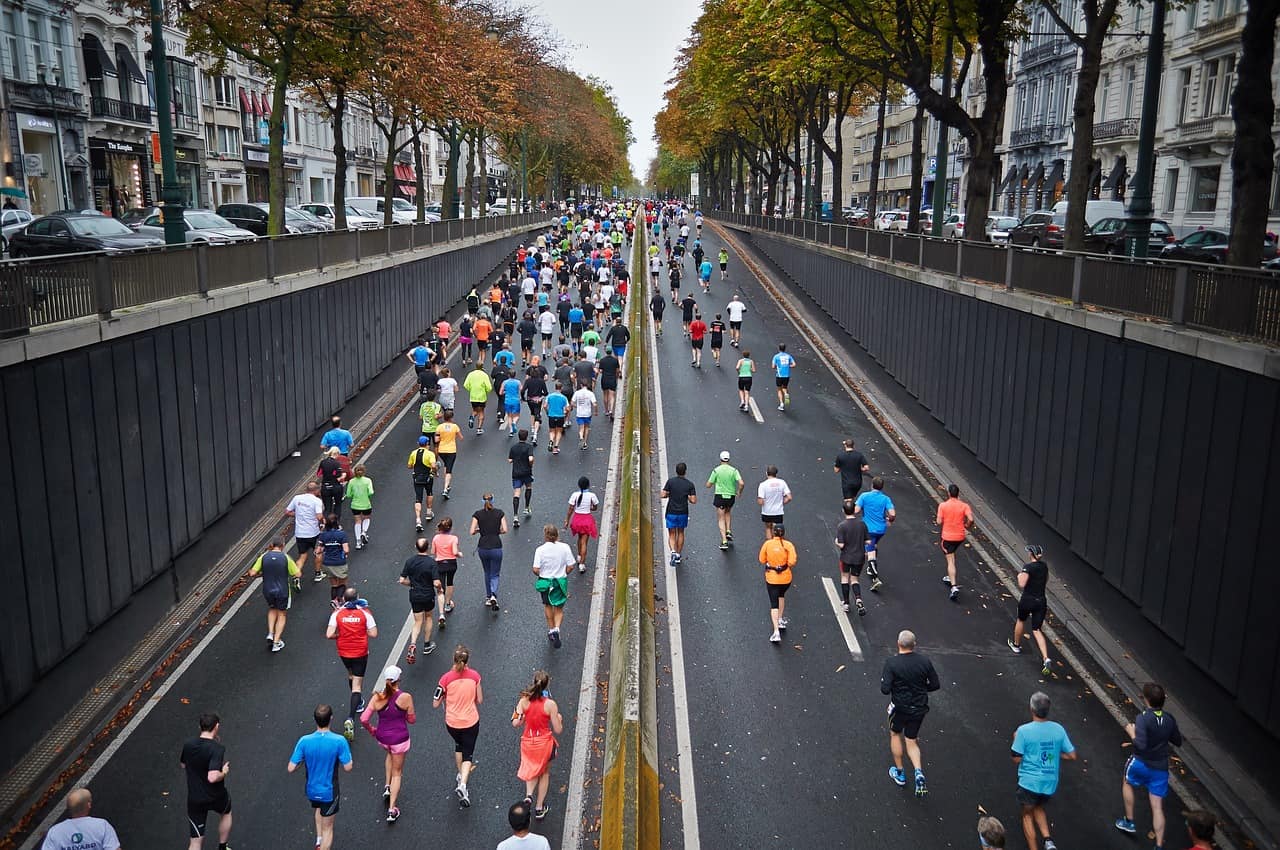
Running for leisure was not a fad until later in the 1960s.
It was the year 1958 when the Chicago Tribune released an issue featuring jogging as the latest strange fitness trend.
You should not drink water in the hour before you run.
Instead, you should drink a good 8 oz. 5 minutes prior. This method is more reliable avoiding seeking the loo on the go.
Even for at least 30 minutes daily, running shows proven health benefits.
It promotes better sleep quality, mood boosts, and concentration levels. Moreover, running aids in the immune system’s fight against colds.
Running also helps social skills.
Experiments from the US National Institutes of Health demonstrated how the activity possesses the potential to encourage children in dealing with being bullied effectively.
Endurance running enhances your nervous system.
During the exercise, the FNDC5 molecules in your brain get activated. This process makes the memory sharper and learning difficult subjects easier.
Doing a short run while at work can increase your productivity by 23%.
This finding from the International Journal of Workplace Health Management could be just the solution you need whenever you are feeling sluggish at work.
During every run, the midbrain sharpens in function.
Because this area is in charge of managing your vision and hearing, you might be able to run without having to wear your glasses!

Selfie-taking is the top thing that annoys runners on a race day.
Next on the list is obstructive pedestrians, followed by phones serving as boomboxes and then runners who invade the wrong corral.
The ‘runner’s face’ can appear on some ultra-runners.
It occurs when a racer’s fats get burned off from their face too fast. Eventually, it creates a resemblant skeleton facade.
The ideal temperature for a race day is 45 degrees Fahrenheit.
Scientific testing revealed the estimation based on body reactions to various temperatures.
The modern-day outdoor track has an oval shape and 8 lanes.
The innermost lane has a 400-meter coverage whereas the outermost lane covers an additional 50 meters. Hence, races stagger the start line to give runners fair distances.
Before 1980, medical science prohibited women from joining marathons.
They used to believe that the exertion from running could tear up uteruses.
The ‘marathon gene’ exists, but not for 20% of humans.
A Loughborough University research claimed that people who do not have those genes can train as much as they like. However, none of them can ensure their victory.
Female boobs also run with their owners.
University of Portsmouth scientists revealed that these lady humps do not simply bounce up and down. Instead, they also do a side-to-side motion that follows a crazy pattern of figure 8 and covers 6 inches of movements per stride.

Her pacing does not matter.
Whether she runs fast or slow, a female’s breasts garner the same amount of movement.
Some runners tend to look forward to shoes more than sex.
Jason Fitzgerald, a marathoner, describes these reactions as something called ‘Shoegasms’.
Drinking water in races with distances shorter than 10 miles were forbidden until the 1960s.
In most of Europe, especially in the United Kingdom, they believed that doing so would only weaken a runner.
The police used to stop people who run for exercise during the 1960s.
The cops find it suspicious seeing grown men running at night. Thus, people opted for morning jogs instead.
The modern-day marathon distance originated from Greece.
A marathon has a distance of 42.195 kilometers, or 26 miles 385 yards. Legend has it that a soldier named Pheidippides delivered the news of the Greeks defeating the Persians in the 490 BC battle. He ran that distance from Marathon, Greece and yelled “Rejoice, we are victorious” upon reaching Athens. However, he died shortly after his big announcement.
The greatest sprinter of all time is Usain Bolt.
The Jamaican sprinter set a record of 44.72 kmh or 27.79 mph in a 100-meter sprint. Bolt also holds the record of the fastest speed of human foot.
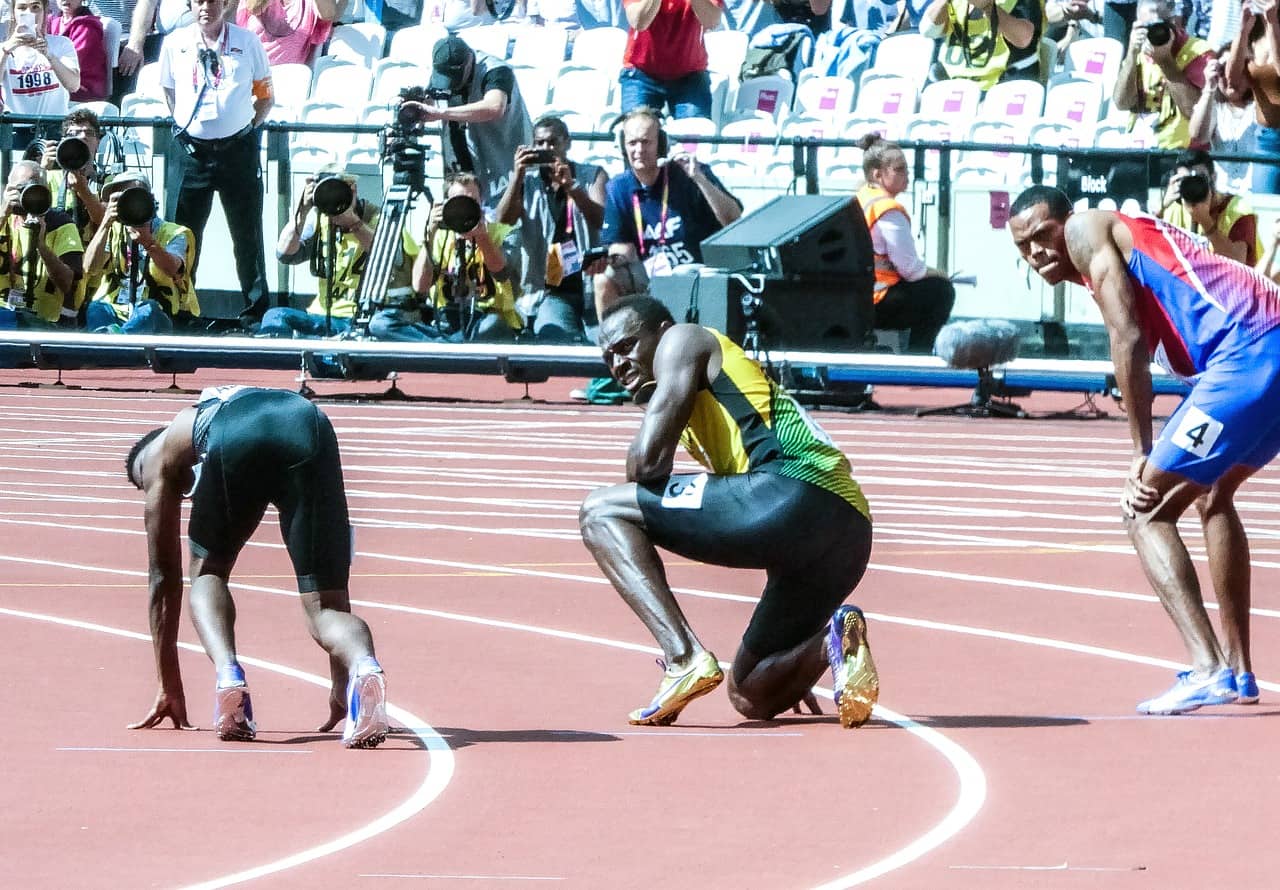
The record of being the youngest marathoner goes to Budhia Singh.
Starting at the young age of 3, the Indian boy trained successfully and was able to finish 48 marathons before turning 5.
The record of being the oldest marathoner goes to Baba Fauja Singh.
The 100-year old British Sikh was 100 years old when he joined the Toronto Waterfront Marathon held in Canada. Fauja finished the race in 8 hours, 25 minutes and 16 seconds, sharing that his secret was having “no ego and no greed”.
The fastest male marathon runner is Eliud Kipchoge.
A Kenya native, Kimetto finished the 2014 Berlin Marathon in 2 hours, 1 minute and 39 seconds. Kipchoge’s record beat Dennis Kimetto, another Kenyan, whose time was 2 hours, 2 minutes, and 57 seconds.
The fastest female marathon runner is Brigid Kosgei.
Being a Kenyan herself, Kosgei seems to be the female version of the record-holder in the male category. She won the 2019 Chicago Marathon in 2 hours, 14 minutes and 4 seconds.
Kosgei beat the 16-year-old reign of Paula Radcliffe.
The British long-distance runner topped the 2003 London Marathon in just 2 hours, 15 minutes, and 25 seconds. It took a significant 1 minute and 21 seconds for the record to be taken away from her 16 years later.
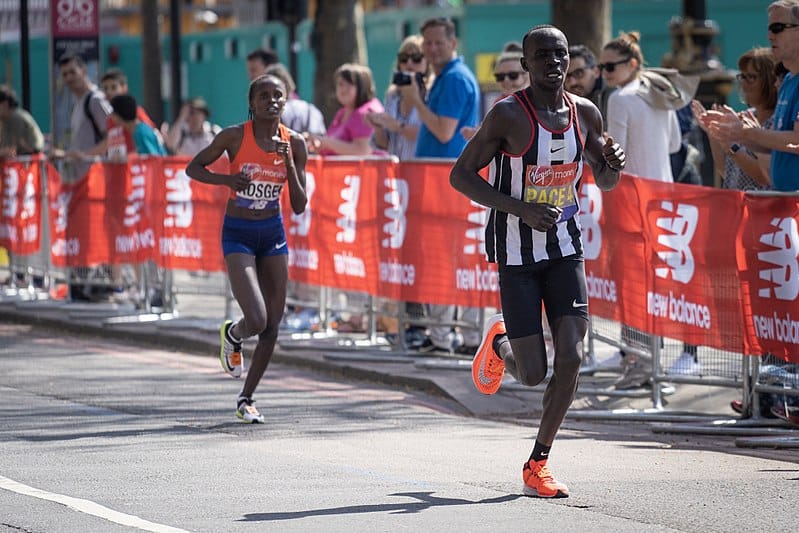
The slowest marathon runner is Shizo Kanakuri.
The Japanese runner originally dropped out of the Stockholm Olympics in 1912. Fifty years later, he was invited to finish the race, setting a record of 54 years, 8 months, 6 days, 5 hours and 32 minutes.
The fastest backward running marathoner is Markus Jurgens.
In the bizarre marathon in Hannover in 2017, Jurgens won with a time of 3 hours, 42 minutes and 41 seconds.
The faster runner in suit and tie is Adam Campbell.
Despite his unconventional running outfit, Campbell finished at 2 hours, 35 minutes and 53 seconds in the Victoria Marathon in 2012.
The first woman to officially run with a bib was Kathrine Switzer.
In the Boston Marathon in 1967, the American runner had to register under K.V. Switzer so that officials would not easily identify her as a female.
The fastest recorded mile ran by a male was Hitcham El Guerrouj.
In 1999, Hitcham El Guerrouj from Morocco completed a mile in 3 minutes, 43.13 seconds.
The fastest recorded mile ran by a female was Sifan Hassan.
The Dutch runner set the women’s mile record at 4 minutes, 12.33 seconds in the Diamond League in Monaco in July 2019.
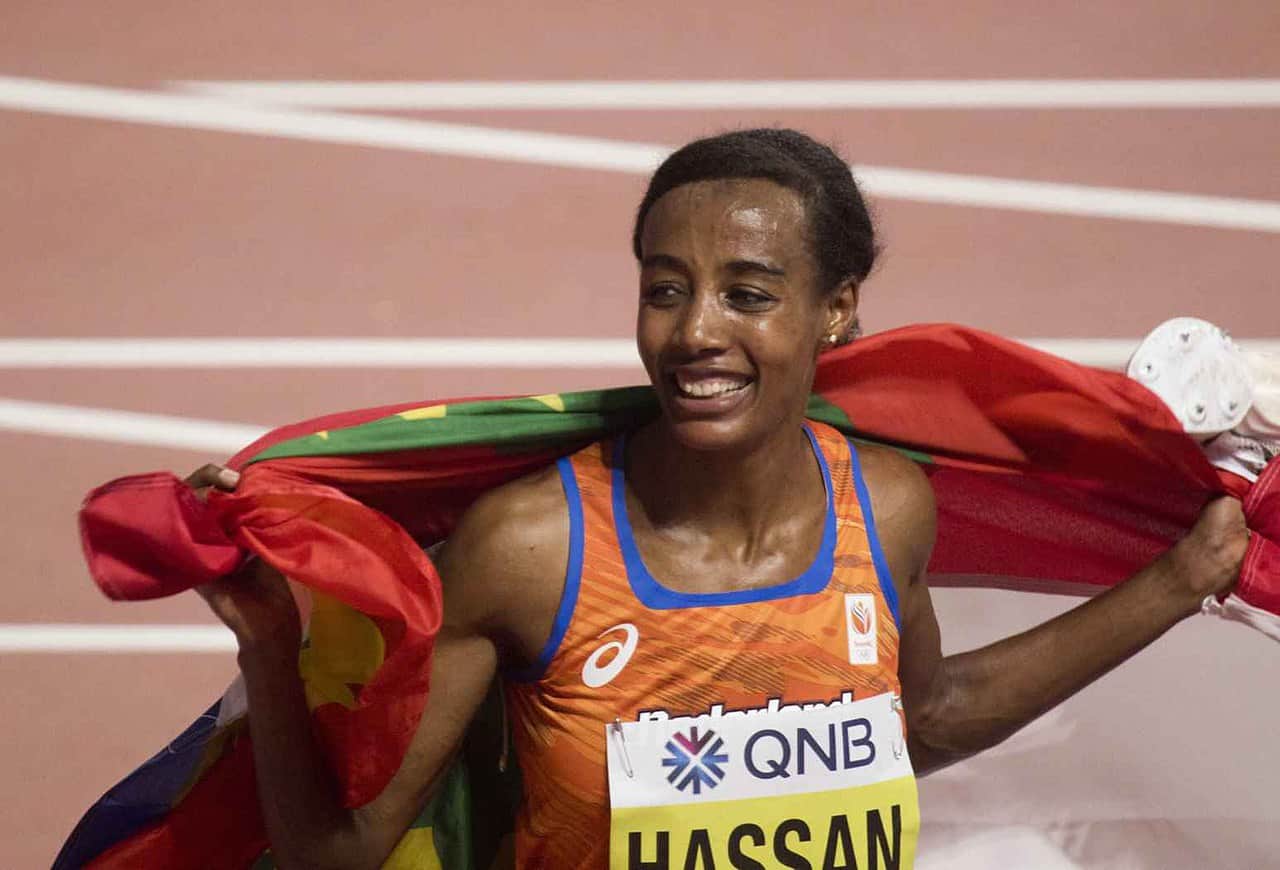
Hassan beat the 23-year-old record of Svetlana Masterkova.
Masterkova remained unbeaten after her record of 4 minutes, 12.56 seconds in the Weltklasse Grand Prix track and field meet held at Zurich, Switzerland.
The first female runner to be featured on the cover page of Sports Illustrated is Jackie Joyner-Kersee.
Dated 1987, the issue had the caption “Super Woman” next to her image.
Stefaan Engels ran a total distance of 15,401 km or 9,569 miles in a year.
The Belgian runner earned the title “Marathon Man”, after running the marathon distance each day for a year.
Melissa Moon won her race with on-the-day borrowed shoes.
She lost her luggage while traveling to the World Mountain Running Championships in 2003. Still, the New Zealander did not let it stop her.
Moon borrowed a pair and even succeeded in her category.
Eating pizza covered in mayonnaise is Bill Rodgers’ secret to success.
His advice could take credit from his four wins at the Boston Marathon, as well as the New York City Marathon. He has also added 1 win at the Fukuoka Marathon to his bag.
What’s more, he was the only runner to ever hold the title of all the 3 major marathons at the same time.
The 1984 Los Angeles Olympics Marathon was a matter of life and death for Dieudonne Lamothe.
Placing last at 78th on the race was not a bad thing at all for the Haitian runner. Whether Lamothe places first or last did not matter as long as he crosses that finish line.
Otherwise, his country’s dictator would have had him killed.
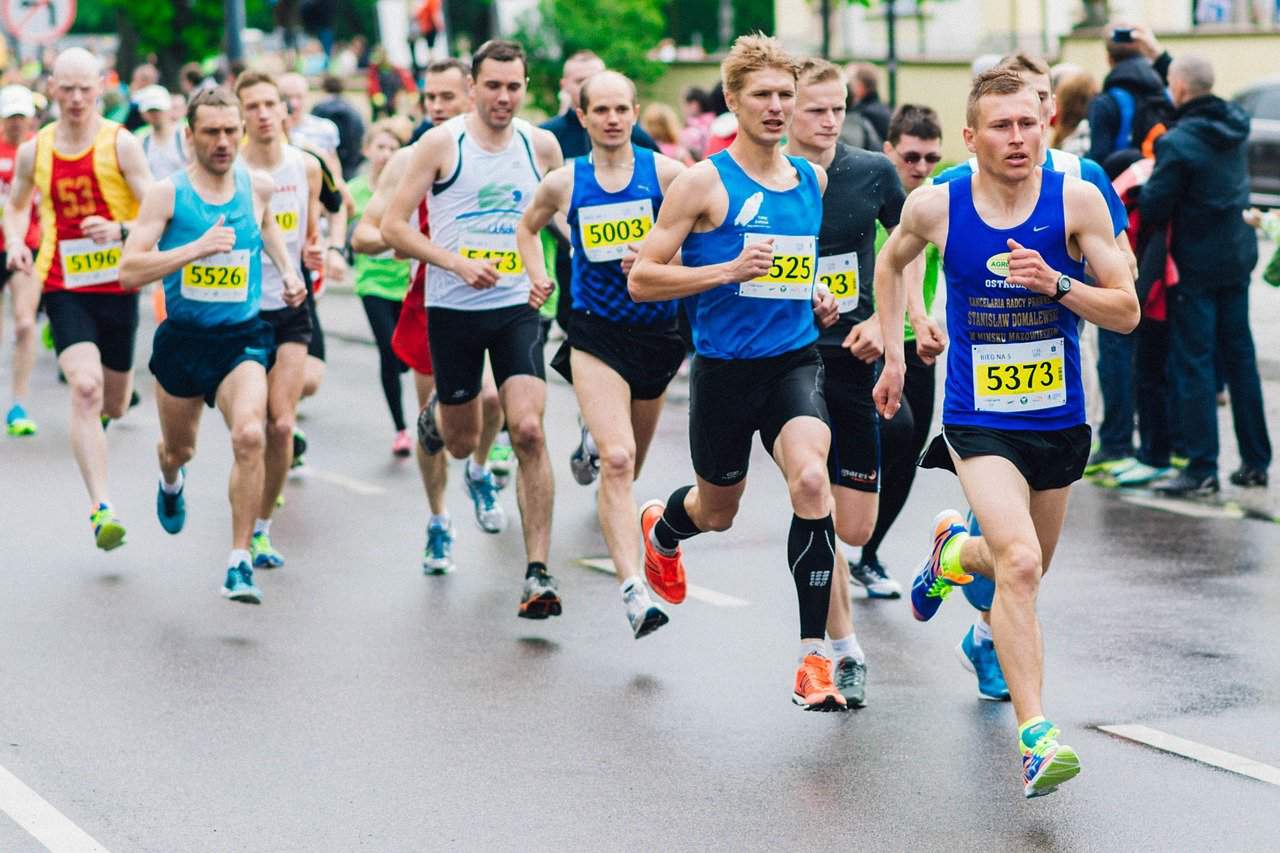
Based on John Dunbar’s experience, beer was not a good thing for running.
He ran out of water supply in the middle of the Ironman triathlon. Then, he opted for beer and ended up rushing towards parked cars instead of racing to the finish line.
Shoes were not necessary for Abebe Bikila’s two marathon victories.
The Ethiopian runner won races barefooted first in the 1960 Rome Summer Olympic Marathon, and second in the 1964 Tokyo Olympics.
Rosa Ruiz could have won the 1980 Boston Marathon, except she should not.
Race officials discovered that the Cuban-American woman only jumped into the marathon about a mile from the finish line. After revealing that she only ran one other marathon which is the 1979 New York City Marathon, officials found out that Ruiz rode the subway on her way to the finish line.
They nullified her records after the ridiculous discoveries.
A woman from suburban Chicago gave birth just hours after finishing the 2011 Chicago Marathon.
Baby bump and all, 27-year-old avid runner Amber Miller ran half of the track and walked through the other half. When her doctor gave her the go signal, she, her second child and her husband went on with it and finished at 6 hours, 25 minutes, and 50 seconds.
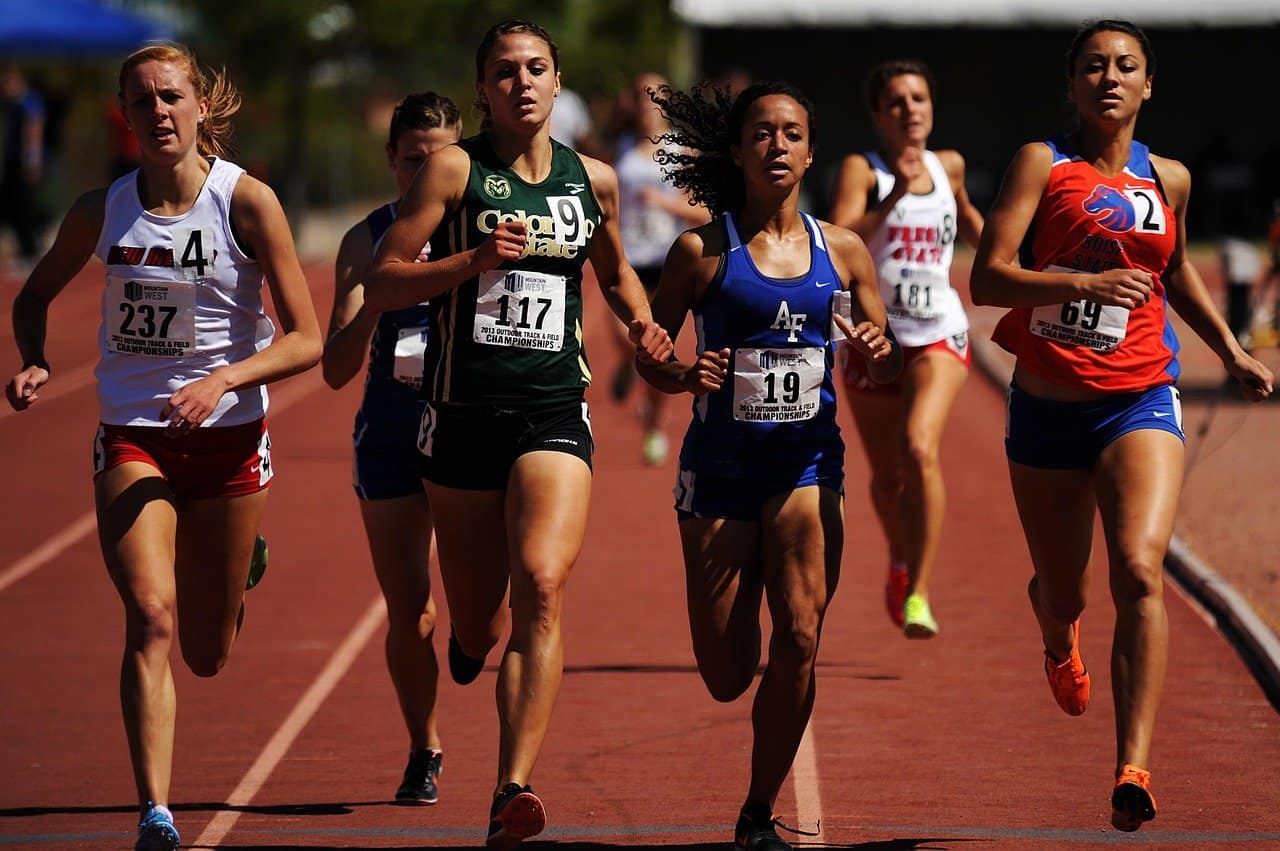
Marathon runs are a thing for celebrities, too.
Some of the famous personalities who finished marathons are President George W. Bush, actresses Katie Holmes and Oprah Winfrey, singer Sean Combs, and actor Will Ferrell.
Northwest Kenyan tribe Kalenjin produces the world’s most notable runners.
Of the top 20 distance runners, twelve hails from the said minority group. Scientists observed that these people, in relevance to height, possess less mass, shorter torsos, longer legs, and even slender limbs.
Also, a researcher described such physique as ‘bird-like’ and how it helped the Kenyans become the efficient long-distance runners that they are.
Men are proven more capable of running longer and much easier than women.
Hearts of males are 20-25% bigger than that of females, particularly the left ventricle. This advantage easily gives them an edge on longevity.
All distances consider men faster than women on average.
The rise in testosterone makes men stimulate development in muscle mass. It also improves the density of their red blood cells and hemoglobin.
Women’s fat is a big deal in running.
Given that this gender is predesigned to carry 10-15% more fat than the other one, it makes running at an equivalent pace more difficult for women. Hence, women have to work much harder.
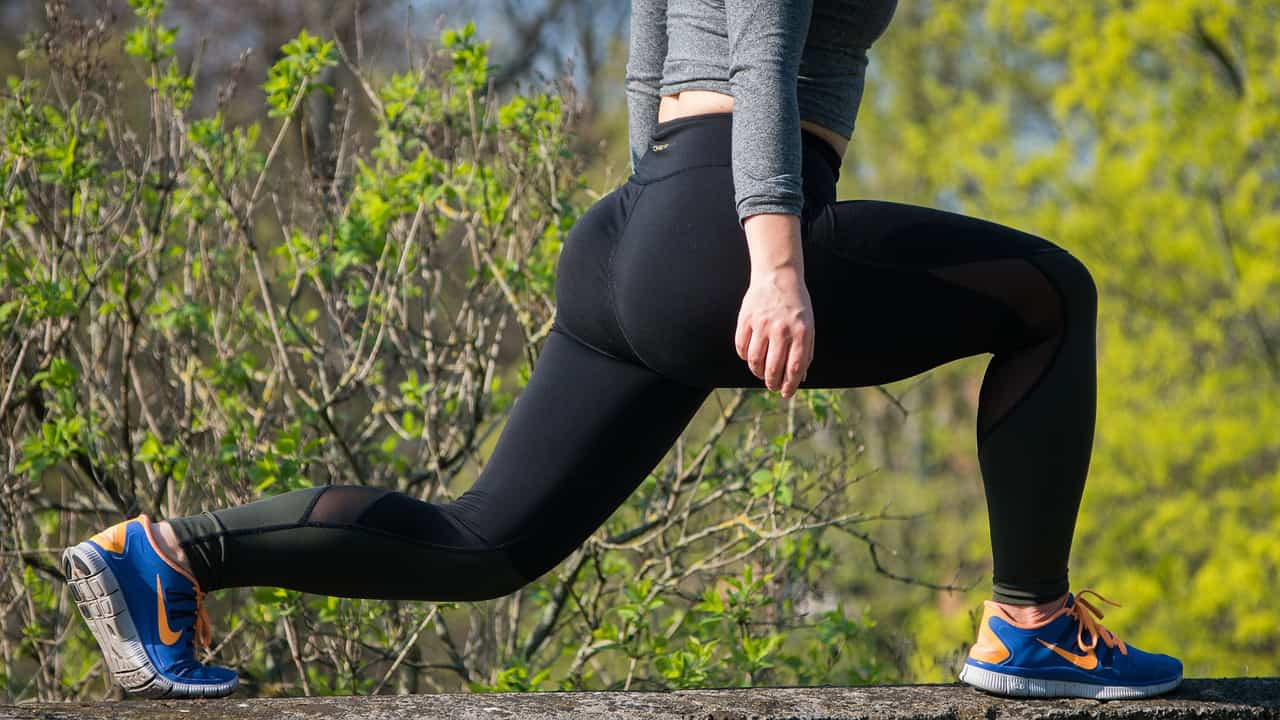
Running activities affect lactating women.
Vigorous running exercises cause the build-up of lactic acid in the body. Therefore, it could make breast milk taste sour as the milk absorbs the lactic acid produced by the activity.
Human hearts build too much pressure when running.
Too much that it is enough to make blood squirt up to 30 feet.
Adidas used to mean a different thing for athletes.
They once thought that the famous shoe brand was an acronym that stands for ‘All Day I Dream About Sex.’
The outsoles of the first-ever Nike shoe was created with a waffle iron.
Nike co-founder and innovator Bill Bowerman used his wife’s old waffle iron to produce his first outsoles in 1972. Back then, he applied for a grant for the athletic shoe that he made especially for artificial turf.
Its sole bore polygon-shaped studs with multiple sides that serve as edge grips and provides enhanced traction. Bowerman’s shoe patent compelled Nike to produce waffle trainers after his recognition on February 26, 1974.
Nike did not produce running shoes specialized for women until 1978.
They produced the Nike Waffle Racer as the first one.
Sports bras did not exist before 1977.
Imagine how it was like for female runners back then, right? Anyway, the garment indeed aided in the improvement of running apparel for women.
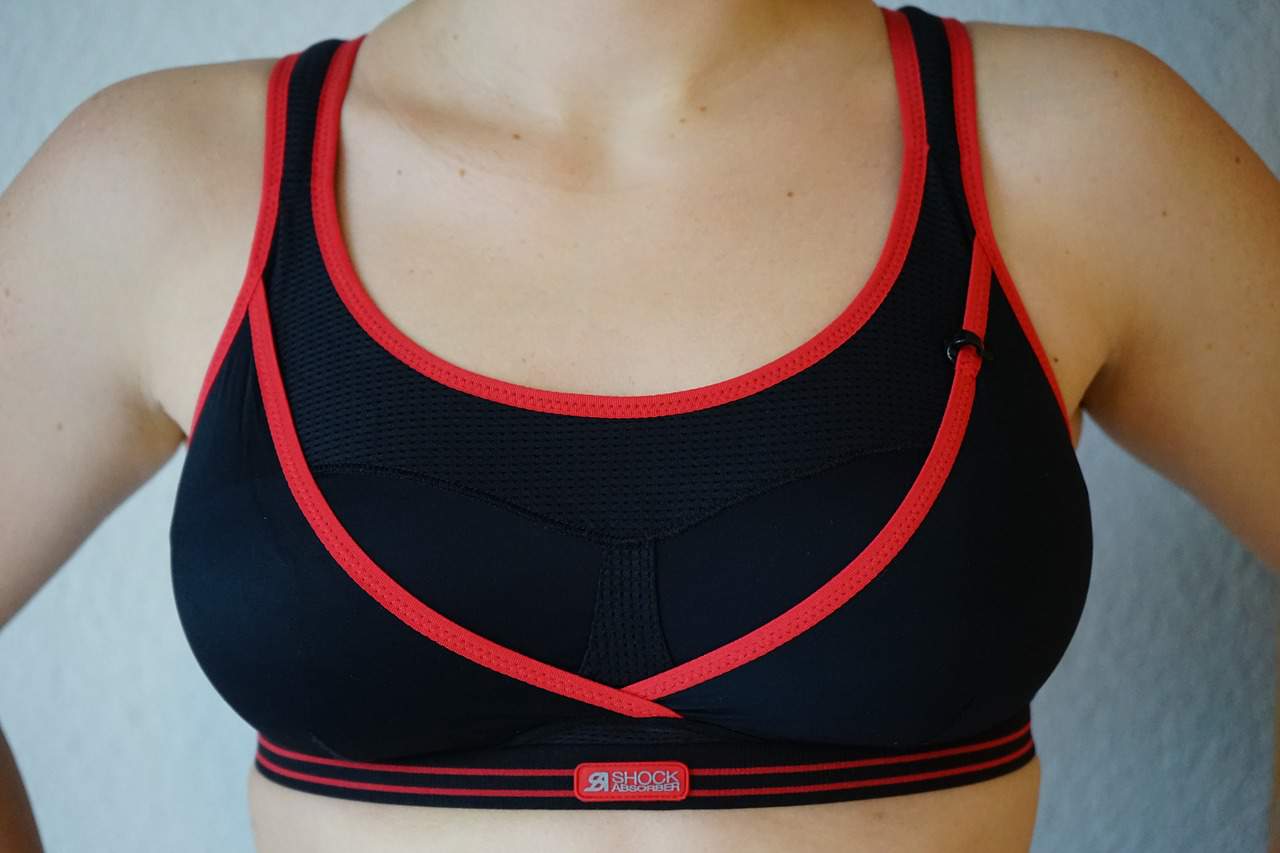
The average turnaround for running shoes is every 300-500 miles or 483-805 km.
While this detail is important for competitive runners, common people might not mind as much. Running shoes worn on a daily basis usually only last about 200 miles.
A running shoe always starts breaking down in the midsole.
On other occasions when the ball of the sole is getting pliant, it is usually a vital sign warning of a damaged midsole.
The record for the oldest indoor marathon in the U.S. is the Zoom!Ya!Ya!
The name is not the only crazy thing about this race and having to run 26.2 miles on a track is not the real challenge here. Contestants would have to change directions every 30 minutes while doing so!
The largest running race in the United States is the Bay to Breakers.
Held in San Francisco, the track garners more than 100,000 participants annually.
The 100-meter Marathon Medoc is the ultimate marathon for foodies.
Contestants have to sip wine at the start line of the annual French event. After that, they navigate through 43 food and beverage stalls before reaching the finish line.
Human runners compete with horses at The Man versus Horse Marathon.
Each year, Llanwrtyd, Wales holds the funny marathon wherein man only won twice in a span of 10 years. For the first 24 years of the event, horses kept on winning.
Finally, Huw Lobb became the first human to win the race in 2004.

The most difficult footrace in the world is the Badwater Ultramarathon.
Only invited participants could join the extreme race. The 135-mile track starts from Death Valley, the lowest spot in North America, and finishes at Mount Whitney, the highest spot in the lower 48 states.
The coolest marathon in the world is the North Pole Marathon.
Based on its name, the race is the farthest race that happens in the north.
The southernmost marathon occurs in Antarctica.
Down there, -4°F is the average temperature of windchill.
The 1972 Boston Marathon was the first competitive marathon to allow women participants.
People back then used to think that such competitions are too exhausting for females.
The race with the largest recorded number of finishers is the Atlanta Peachtree Road Race.
A total of 54,752 finishers succeeded in the 2015 event. Meanwhile, the NYC marathon comes in second with only a few above 50,000.
The first New York City Marathon was held in 1970.
That time, only 127 participants joined for a registration fee of $1.
The Great Wall Marathon is a 5,164-step challenge.
The 26.2 miles of the famed wall in China is indeed nowhere near simple running.

The oldest obstacle course race is Tough Guy.
First held in 1987, the extraordinary competition served as an inspiration for the Mud Run and Spartan. They ended up creating a completely different running world.
The hottest race ever held was the Kauai Marathon.
On average, the event day in Poipu, Hawaii has a temperature of 26°C or 80°F . Its counterpart is the Winterman Marathon in Ottawa, Canada with an average temperature of -5°C or 23°F.
The largest recorded running event was “A Run for the Pasig River”.
The run for a cause from the Philippines was held on October 10, 2010, and garnered 116,086 participants.
The oldest annual marathon is the Boston Marathon.
Launched in 1897, the event started with 24.5 miles between Metcalf’s Mill in Ashland and the Irvington Oval in Boston. The association extended the distance to 26 miles in 1924 to follow the Olympic standard.
Since then, the starting line was held in Hopkinton, west of Ashland.
The world record for the highest marathon is the Everest Marathon (obviously).
Starting from the line at Gorak Shep, runners would run 5,184 meters or 17,000 feet towards the finish line near the Everest Base Camp in Nepal.

On the opposite, the lowest marathon is the Tiberias Marathon.
It starts from 200 meters below sea level down the Jordan Valley.
Among the outdoor runners, around 56% end up getting a runny nose.
When the air is cool or dry, nasal mucus production increases during the activity under such settings.
The ‘runner’s knee’ is considered as the most common injury in running.
Also known as patellofemoral pain syndrome (PFPS), the condition refers to the inflammation of the cartilage located under the kneecap.
Other frequent injuries are the Achilles tendinitis, plantar fasciitis, shin splints, and stress fractures.
Poor-fitting shoes could cause black toenails.
Unfortunately, it is another usual occurrence among runners. Bleeding under the toenails causes the black color.
For long-distance runners, the ‘dead-butt syndrome’ is a frequent fate.
True to its name, it is characterized by a sore feeling in the tendons of a patient’s rear end.
The treadmill was not always a piece of workout equipment.
In the past, English prisons utilize this machine for punishment purposes. Even the famous author Oscar Wilde experienced the torment of having to run on the treadmill in the duration of his 2-year sentence.
Was this page helpful?
Our commitment to delivering trustworthy and engaging content is at the heart of what we do. Each fact on our site is contributed by real users like you, bringing a wealth of diverse insights and information. To ensure the highest standards of accuracy and reliability, our dedicated editors meticulously review each submission. This process guarantees that the facts we share are not only fascinating but also credible. Trust in our commitment to quality and authenticity as you explore and learn with us.


